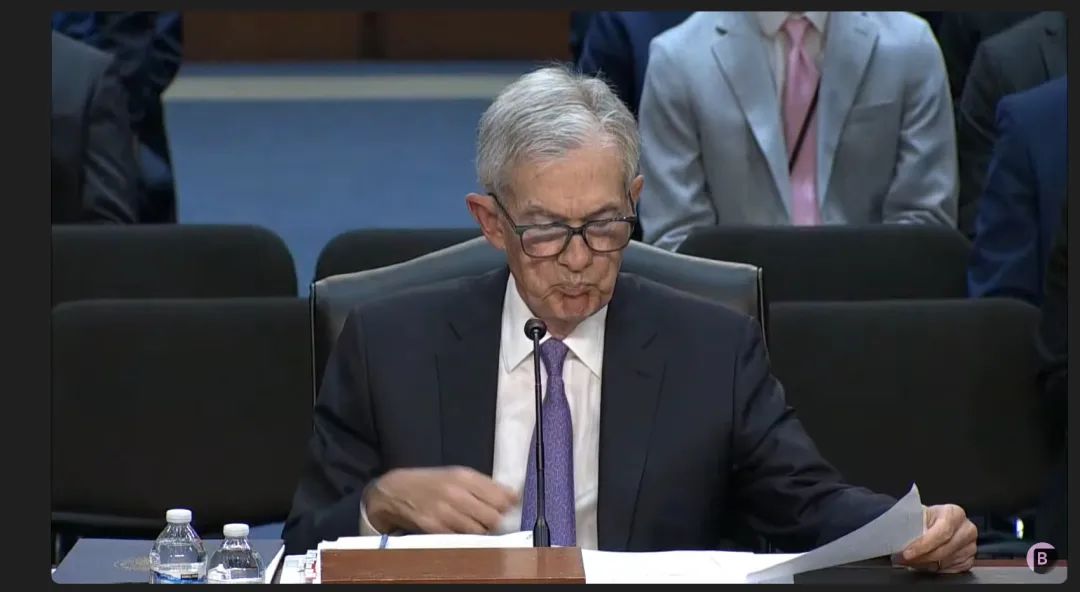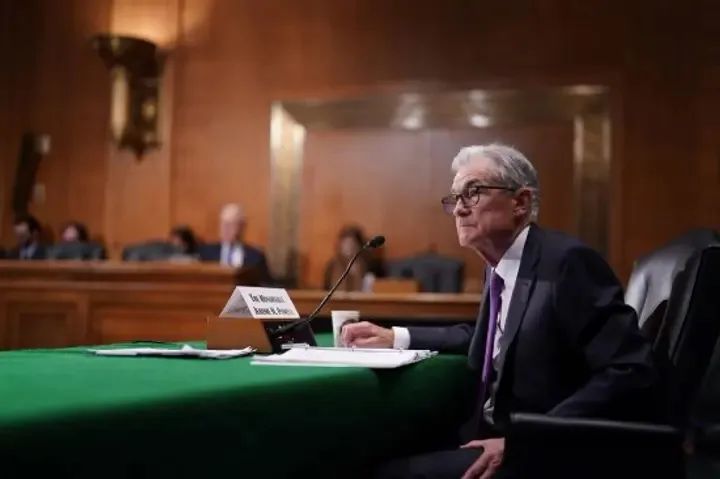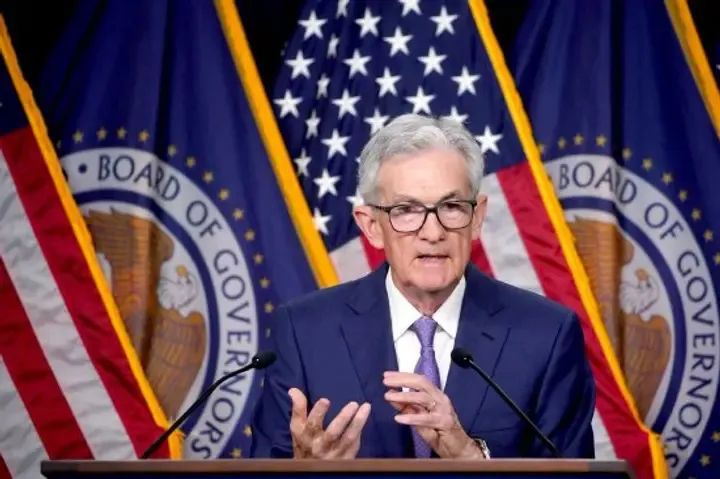鲍威尔证词即时解读:比预期更鹰派
今日鲍威尔做证词,以下为英文全文:
The Federal Reserve remains squarely focused on our dual mandate to promote maximum employment and stable prices for the benefit of the American people. Over the past two years, the economy has made considerable progress toward the Federal Reserve's 2 percent inflation goal, and labor market conditions have cooled while remaining strong. Reflecting these developments, the risks to achieving our employment and inflation goals are coming into better balance.
I will review the current economic situation before turning to monetary policy.
Current Economic Situation and OutlookRecent indicators suggest that the U.S. economy continues to expand at a solid pace. Gross domestic product growth appears to have moderated in the first half of this year following impressive strength in the second half of last year. Private domestic demand remains robust, however, with slower but still-solid increases in consumer spending. We have also seen moderate growth in capital spending and a pickup in residential investment so far this year. Improving supply conditions have supported resilient demand and the strong performance of the U.S. economy over the past year.
In the labor market, a broad set of indicators suggests that conditions have returned to about where they stood on the eve of the pandemic: strong, but not overheated. The unemployment rate has moved higher but was still at a low level of 4.1 percent in June. Payroll job gains averaged 222,000 jobs per month in the first half of the year. Strong job creation over the past couple of years has been accompanied by an increase in the supply of workers, reflecting increases in labor force participation among individuals aged 25 to 54 and a strong pace of immigration. As a result, the jobs-to-workers gap is well down from its peak and now stands just a bit above its 2019 level. Nominal wage growth has eased over the past year. The strong labor market has helped narrow long-standing disparities in employment and earnings across demographic groups.1
Inflation has eased notably over the past couple of years but remains above the Committee's longer-run goal of 2 percent. Total personal consumption expenditures (PCE) prices rose 2.6 percent over the 12 months ending in May. Core PCE prices, which exclude the volatile food and energy categories, also increased 2.6 percent. After a lack of progress toward our 2 percent inflation objective in the early part of this year, the most recent monthly readings have shown modest further progress. Longer-term inflation expectations appear to remain well anchored, as reflected in a broad range of surveys of households, businesses, and forecasters, as well as measures from financial markets.
Monetary PolicyOur monetary policy actions are guided by our dual mandate to promote maximum employment and stable prices for the American people. In support of these goals, the Committee has maintained the target range for the federal funds rate at 5-1/4 to 5-1/2 percent since last July, after having tightened the stance of monetary policy significantly over the previous year and a half. We have also continued to reduce our securities holdings. At our May meeting, we decided to slow the pace of balance sheet runoff starting in June, consistent with the plans released previously. Our restrictive monetary policy stance is helping to bring demand and supply conditions into better balance and to put downward pressure on inflation.
The Committee has stated that we do not expect it will be appropriate to reduce the target range for the federal funds rate until we have gained greater confidence that inflation is moving sustainably toward 2 percent. Incoming data for the first quarter of this year did not support such greater confidence. The most recent inflation readings, however, have shown some modest further progress, and more good data would strengthen our confidence that inflation is moving sustainably toward 2 percent.
We continue to make decisions meeting by meeting. We know that reducing policy restraint too soon or too much could stall or even reverse the progress we have seen on inflation. At the same time, in light of the progress made both in lowering inflation and in cooling the labor market over the past two years, elevated inflation is not the only risk we face. Reducing policy restraint too late or too little could unduly weaken economic activity and employment. In considering adjustments to the target range for the federal funds rate, the Committee will continue its practice of carefully assessing incoming data and their implications for the evolving outlook, the balance of risks, and the appropriate path of monetary policy.
Congress has entrusted the Federal Reserve with the operational independence that is needed to take a longer-term perspective in the pursuit of our dual mandate of maximum employment and stable prices. We remain committed to bringing inflation back down to our 2 percent goal and to keeping longer-term inflation expectations well anchored. Restoring price stability is essential to achieving maximum employment and stable prices over the long run. Our success in delivering on these goals matters to all Americans.
Let me conclude by emphasizing that we understand that our actions affect communities, families, and businesses across the country. Everything we do is in service to our public mission.
Thank you. I am happy to take your questions.
以下为AI大模型的翻译,爱来自Llama3:
联邦储备委员会始终专注于双重目标,即促进最大就业和稳定物价,以利益美国人民。在过去两年中,美国经济已经取得了对联邦储备委员会2%通胀目标的很大进步,同时劳动力市场状况也趋向于放缓,而仍然强劲。反映这些发展,我们实现双重目标的风险正在变得更平衡。
在货币政策方面,我将回顾当前经济情况,然后转移到货币政策上。
最近指标表明,美国经济继续以坚实的速度增长。国内生产总值增长似乎在今年前半期放缓,而在去年后半期则非常强劲。私人内需需求仍然强劲,但消费支出增长也趋向于放缓。同时,我们已经看到资本投资和住宅投资在今年的增长。供应状况的改善支持了需求的恢复和美国经济强劲的表现在过去一年中。
各种指标表明,劳动力市场的状况回到了疫情前的水平,即强劲,但不 太过热。失业率已经上涨,但是仍然在4.1%的低水平。在今年前半期,我们平均每月新增就业岗位223,000个。过去两年来的强劲就业创造和劳动力供给的增加都反映出劳动力的增长,其中包括25-54岁年龄段的人口参与率的增加和移民的速度加快。这导致了工作缺口的收缩,仅略高于2019年的水平。实际工资增长趋向于放缓。在强劲的劳动力市场中,我们帮助减少了长期存在的就业和收入差距。
过去两年中的通胀已经明显下降,但仍然高于委员会的2%目标。总人均消费支出价格在5月份到12个月内增长2.6%。核心PCE价格,也就是不包括食物和能源类别的价格,同样增长2.6%。今年早期没有实现对目标的进步,而最近的一些月份读数表明我们取得了一些进一步的进步。但是长期通胀预期仍然保持稳定,这反映出各种调查结果、企业和预测家的看法,以及金融市场的措施。
我们的货币政策行动由双重目标指导,即促进最大就业和稳定物价,以利益美国人民。在支持这些目标下,我们已经维持了联邦存款准备金率目标区间5-1/4%到5-1/2%,自去年7月以来没有变化。此外,我们还继续维持着低息政策。我们不认为在我们得到了更大的信心,通胀正在向2%目标移动之前,我们将不会减少联邦存款准备金率目标区间。
最近的通胀读数表明我们取得了一些进一步的进步,而好的数据结果将加强我们的信心,认为通胀正在向2%目标移动。
我们继续每次会议作出决策,我们知道如果减少政策太早或太晚,将会导致通胀的回暖或反转。在考虑调整联邦存款准备金率目标区间时,我们将继续评估最新数据和它们对展望、风险平衡和适当货币政策路径的影响。
我要强调的是,我们理解我们的行动会影响美国各地社区、家庭和企业。我们的一切都是为了我们的公共使命。
谢谢,欢迎提问。
鲍威尔证词公布后,美元指数拉升,现货黄金下挫,交易员依旧押注9月开始降息,年内降息两次,分析师认为,这份证词比预期鹰派,因为再次提到了需要更多进展和更久的紧缩政策,而不是专注于降温的CPI和走高的失业率,本月降息是不太可能的,不过年内降息是可以确信的,但到底是一次还是两次取决于后续的需要了,就周四的CPI来预测,9月降息应该是问题不大,关键在于剩下一次降息到底有没有可能了。笔者认为,这份证词确实比预期的要鹰派一些,因为还是强调好的消息,对失业率上升似乎没有特别的担忧,而称劳动力市场开始平衡,经济降温,风险双向,没有那么的鸽派,虽然开始转向。彭博社记者Steve Matthews表示,总体而言,鲍威尔的货币政策似乎相当平衡。最近的通胀数据显示,进一步的温和进展和更多好的数据将增强美联储对通胀率回到2%的信心,这是降息的条件。鲍威尔强调,政策存在两面风险:行动太早或行动太晚。鲍威尔称劳动力市场“强劲,但并未过热”——这清楚地表明美联储并没有试图进一步缓和就业市场。
让我们继续等待周四的CPI报告和9月会议前的更多数据,还有下月的杰克逊霍尔。
免责声明:上述内容仅代表发帖人个人观点,不构成本平台的任何投资建议。






